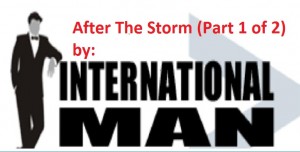This sent in by a listener who noticed it first at Survivalblog.com. The first of a two-part series, I think the author has an accurate assessment of the stages of the collapse. This is a good overview of each stage and gives us good indicators to recognize where we’re at, and what we can expect next.
-JJS
The 11 Stages of the Collapse
 After the Storm (Part 1 of 2)
After the Storm (Part 1 of 2)
With all the study and thought that are required to make sense out of how the Great Unraveling will play out, we seldom take time to think of what it will be like on the other side. Those of us who are, by nature, long-term thinkers and/or optimistic, have a vague picture in mind of a rebirth of libertarian thinking, and a vibrant economy. However, we tend not to think too much more about these hopes than that, because we are caught up in the Great Unraveling itself – a very time-consuming topic.
The other day, an associate whom I like to think of as having a decent, if not holistic, view of the present depression, commented to me, “I wish we could just have the crash tomorrow and everything that goes with it, so that, next year, we can get back to normal.”
Oops … maybe his expectations are a bit more simplified than I thought. And, if others share his view, possibly the topic needs a bit of fleshing-out. While it may not be ready to be a prime topic of the ongoing conversation, possibly an outline of what may happen after all the fireworks have gone off would be in order.
Ten Years Down and Ten Years Up
Economic wizard (and favourite ‘Uncle’) Harry Schultz stated back in the early 2000’s that what he anticipated was “ten years down and ten years up.” At the time, many thought that his projection was extremely prolonged. I didn’t think so. People do commonly seem to take the view that, once the various crashes have taken place, we simply walk out into the sun, brush the dirt off the knees of our trousers, and, with a spring in our step, walk into the bright new day.
However, a depression is not at all like that. It is more like a town after a hurricane has hit. The storm may have been swift, but the recovery is not. Power lines are down. Roads are blocked. Homes and stores have been destroyed. Having personally been highly involved in the reconstruction of a small country after the devastation wrought by a category five hurricane, I can attest that, even if the population is hardworking and motivated (which they were), the task of rebuilding is monumental, and the time period required to achieve it is prolonged.
I see the period after the various crashes very differently from those who anticipate immediate recovery symptoms. This is not because I imagine myself a visionary; my view is based on history. If we look at the economic collapses of the past, (inclusive of their possible knock-on effects, such as hyperinflation and destruction of the currency), from the fall of the Roman Empire to Weimar Germany, to Argentina and Zimbabwe – take your pick – the pattern is extremely similar.
So, let’s have a look at that pattern and ask ourselves if the present situation might not play out much the same (except far worse and more prolonged, as the conditions that led to this particular depression have been more extreme). The various stages are likely to be a given, but the various factors within each stage are a bit more uncertain. In every major economic collapse, some combination of these factors takes place.
Also, consider that the stages themselves are like dominoes – they almost always fall in order. The reason? Details change in history, but human nature remains the same. The same knee-jerk reactions by people will repeat themselves over and over. (As an example, we are now experiencing a decline in exports from the First World. I believe that a repeat of the disastrous Smoot-Hawley Tariff of the 1930’s will be passed in America, which undoubtedly would trigger increased hardship for Americans.)
Stages of The Crash
The stages are laid out below. The first three have already occurred.
1 INITIAL CRASHES
- Crash of the residential property market
- Crash of the commercial property market
- Crash of the stock market
2 INITIAL KNOCK-ON EFFECTS OF CRASHES
- Loss of homes
- Loss of jobs
- Inflation
3 IMMEDIATE ACTIONS BY GOVERNMENT
- Bailouts for select groups
- Dramatic increase of debt
- Politicians going in the opposite direction of a real solution
The first knee-jerk reaction began immediately, with the Government attempting to “make the problem go away” as quickly as possible. Almost invariably, at this stage, the corrective strategy is hastily prepared and shortsighted, assuring further deterioration of the economy.
In this stage, the politicians on both sides fail to focus on a real solution. Instead, their primary focuses are, first, to avoid a painful real solution, and, second, to engage in finger-pointing, each political party blaming the other for the problem. The problem worsens steadily until one of the next series of major dominoes falls. This is usually sudden and triggers the toppling of other dominoes.
4 SECOND WAVE OF CRASHES
- Major crash in stock market
- Currency plummets
- Increased bankruptcies
- Increased unemployment
Read the full article at International Man to read 5 through 11:
5 INTERNATIONAL TRADING PARTNERS REACT
6 GOVERNMENT INSTITUTES DESPERATE SELF-DESTRUCTIVE MEASURES
7 ECONOMY REACTS IN LOCKSTEP TO GOVERNMENT ACTIONS
8 SYSTEMIC COLLAPSE
9 SOCIAL COLLAPSE
10 MARTIAL LAW
11 REVOLUTION




I think our friend “International Man” has hit the ‘Proverbial nail’ on the head, with his synopsis!
For a glimpse of what it very well may look like; take a look at this up-comming movie: “Gray State” has to offer!-Trailer below-
http://www.youtube.com/watch?v=Gy7FVXERKFE
“Gray State” website:
http://www.graystatemovie.com/
…It may be comming sooner than most think…
Dr.QueST
His analysis is very accurate. This whole collapse is likely to unfold very much like the Stock Market Crash of 1929 leading all the way to 1933 when FDR made it illegal for private investors to hold gold. And once he had confiscated all of the gold, he bumped up the price from ~$20 to ~30 an ounce, crushing the purchasing power of the dollar. I’m sure we’ll see some more federal subsidization of “vital” industries supposedly to help competition along with some more devaluation of our currency through another QE after the election.
[…] Read Part 1 HERE […]